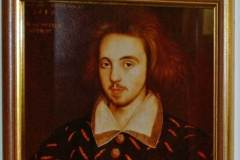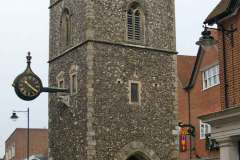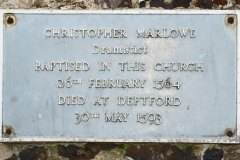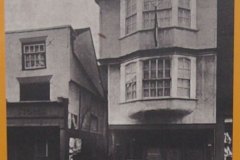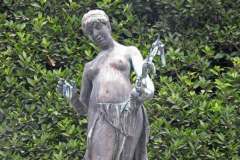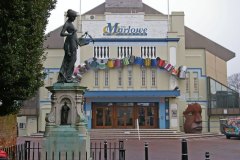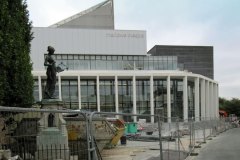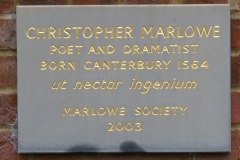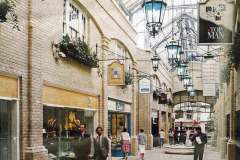Dramatist & Poet
Christopher Marlowe (image 1) is an English dramatist and poet of major importance – according to the Victorian critic Swinburne “Before Marlowe there was no genuine blank verse and no genuine tragedy in our language”. He was born in 1564 in Canterbury to a local shoemaker and died in 1593 in a Deptford house (not an inn as thought for many years) from a dagger struck above his right eye. Writers for over 400 years have disputed whether this was a suspicious death – possibly an assassination – or merely the result of a drunken brawl. Marlowe’s baptismal entry appears in the registers of St George’s parish church for 26 February 1564. The church was seriously damaged by German air raids of 1944, but its tower still stands (image 2), bearing a suitable plaque (image 3) to Canterbury’s greatest son. The family home was supposedly a Tudor house which stood until the 1940s on the corner of St George’s Street and St George’s Lane (image 4).
Marlowe’s Canterbury links are now marked in several ways. The Marlowe memorial (image 5) was initially unveiled by the actor Henry Irving* in the Buttermarket in September 1891. It takes the form of a life-size bronze statue of the scantily dressed ‘Lyric Muse’, designed by the sculptor Onslow Ford. Four niches in the base were intended for additional figures taken from Marlowe plays, but limited funds meant only one (a bronze statuette of Tambourlaine, modelled on Henry Irving) could be filled. Townsfolk nicknamed the Muse ‘Kitty’, and, despite the addition of an evergreen shrub surround, many objected to her presence so close to the cathedral. Iron railings and four corner lamps were added in the following year. In 1921 the memorial was moved to Dane John gardens to be replaced in the Buttermarket by the WWI war memorial. The three missing figures (Johnston Forbes-Robertson as Dr Faustus, Edward Alleyn playing Barabas in The Jew of Malta, and Walter Hackett playing Edward II) were added in 1928. When in 1940 the memorial suffered bomb blast damage, it was put in storage for the remainder of the war, and re-erected in 1948. Unfortunately the main statue was placed facing the wrong way round, causing embarrassment when members of the prestigious Marlowe Society arrived to lay a commemorative wreath in 1957. Laid against Marlowe’s name, the wreath appeared to be paying homage to Kitty’s backside! The memorial moved for a second time in 1993, to stand appropriately by the Marlowe theatre (image 6). It gained a new backdrop with the rebuilding of Marlowe theatre (image 7) which opened in October 2011. A small Marlowe Society plaque could once be seen close to the theatre (image 8) – the Latin translates as ‘Genius is like nectar’. This plaque appears to be lost.
Marlowe’s name is now found on streets, buildings, a restaurant and other businesses across the city. The Marlowe Arcade is a major retail development completed in 1985, initially with a central fountain (image 9) which has since been removed. Built in expensive, shaped, red brick, it receives a mention in the odd story of the Rose Lane car park.
*To read the text of Henry Irving’s speech click here
Sources: Building 26 July 1985; The Times 17 September 1891, 26 October 1928, 16 January 1957 and 19 January 1957; Kent Gazette 5 July 1892; Urry (1988)
DL

